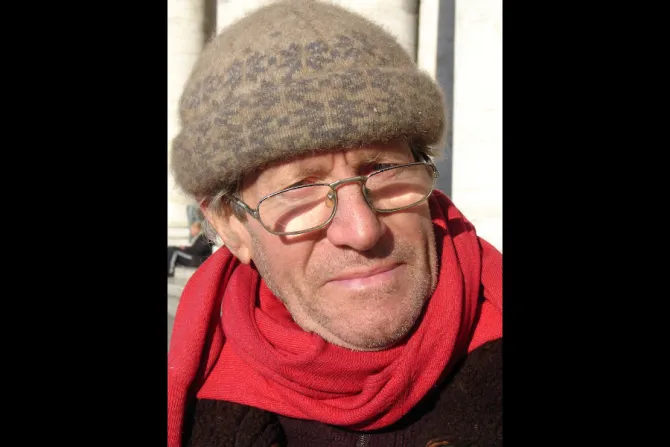Vatican City, Feb 27, 2015 / 15:08 pm
Willy Herteleer, a homeless man who lived on the side streets outside St. Peter's Basilica, made headlines after his death, when he received a special burial in the Vatican's Teutonic Cemetery. The following is an account of his story as told by Msgr. Amerigo Ciani, a canon of St. Peter's Basilica and painter who had become friends with Willy.
Everyone in the neighborhood outside the Vatican knew Willy Herteleer.
The "Borgo" – as the area that borders St. Peter's Square to the north is called – has a small-town-feel. Alongside the monsignors, sisters, cardinals and Romans that live in the neighborhood, there are many homeless people. You can see them every morning at Mass at the Pontifical Parish of Sant'Anna, just off the Borgo inside the Vatican walls.
Willy was one of them.
His austere appearance, the cross around his neck and the pull-cart he had turned into a piece of luggage to carry everything he owned left an imprint.
He participated in Mass every morning. "My medicine is Communion," he always said. He was always well-groomed, but didn't seek much conventional medical attention.
Willy was one of the many men and women who live on the side streets around St. Peter's, men and women who live on the margins of the tourist routes, who have friends throughout the neighborhood.
Among his closest friends were an Italian monsignor, an American religious sister and a German journalist.
More than 80 years old, Willy died one day in December at the hospital near the Vatican where he would often visit to use the bathroom or clean up a bit.
He had to look good because his days were spent as a street evangelizer. After morning Mass, he would stop for a while and speak with the people.
"When did you last go to confession?" he would ask everyone he met. "Are you going to communion? Do you go to Mass?"
He asked the same of other homeless people, those with whom he chose to live.
For a time he lived in a shelter. "Yes, it's nice, welcoming and clean. Yes, you eat well and the people are nice," he told people. "But I need freedom. I love freedom!"
He preferred his friends. He preferred the streets. He preferred the monsignor that brought him oranges, the journalist that took his photo.
After Mass, he would speak with his friend Msgr. Amerigo Ciani. "Thanks for your homily pronounced so calmly. I understand it well and it helps me to meditate throughout the day," he said.
On Dec. 12, the feast of Our Lady of Guadalupe, Pope Francis was celebrating Mass in St. Peter's Basilica when Willy left his earthly life. His friends began to search for him when he did not show up to the usual morning Mass later that week.
One of them, a German named Paul Badde, had only recently become a confrere in the Confraternity of the Camposanto of the Teutons and Flemish, a small cemetery in the Vatican. He proposed that Willy – who was Flemish – be buried there, among the "confreres."
The confraternity is made up of priests and men and women of German descent. German priests reside on campus, in a residence just next to the cemetery. It is all contained all within the Vatican walls, but is autonomous and independent – a little piece of Germany.
The cemetery dates back to the times of Charlemagne, who gave the piece of land next to St. Peter's Basilica as a burial plot for pilgrims from German and Flemish lands who perished on their journey.
Willy's friends organized everything, obtaining the necessary permission from the Vatican, Italy and Belgium, where Willy began his life. They made contact with his family – his four children whom he had not seen for decades.
Fr. Hans-Peter Fischer, rector of the Camposanto Teutonico, celebrated his funeral Mass, along with Msgr. Ciani. Some of Willy's friends were present, including Franciscan Sisters of the Eucharist Sr. Judith Zoebelein.
"Although he was alone, he didn't feel alone," said Msgr. Ciani in the homily. "The presence of God was strong and alive within him. He prayed and prayed. He prayed for the conversion of everyone, even for strangers to repent."
And, that's how Willy's story on earth finishes, with a tomb in the Vatican's cemetery, surrounded by the affection of those who were close to him in life.
His was a life lived in the margins, but a life full of love.


